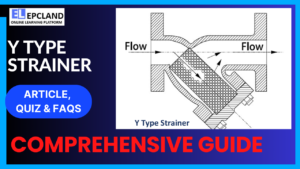Understanding Butterfly Valves: Applications, Advantages, and Disadvantages
Butterfly valves are a staple in piping engineering, known for their versatility and efficiency in controlling fluid flow. This guide delves into the various uses, key benefits, and potential drawbacks of butterfly valves, drawing insights from expert perspectives to provide a comprehensive overview for professionals and enthusiasts alike. Understanding these aspects is crucial for selecting the right valve for specific applications, ensuring system reliability and performance.
Check the complete course on Piping Engineering
Multiple Choice Questions about Butterfly Valves
Here are 10 multiple choice questions to test your understanding of butterfly valves, based on the information presented.
Question 1: Which of the following is NOT listed as a fluid service where butterfly valves are commonly used?
Question 2: A significant advantage of butterfly valves in large diameter pipe systems is their:
Question 3: How much turn is typically required to fully open or close a butterfly valve?
Question 4: What is a benefit of butterfly valves regarding pressure drop when fully open?
Question 5: Butterfly valves with non-metallic seats like rubber or PTFE are suitable for which type of environment?
Question 6: Which of the following is considered a limitation of butterfly valves?
Question 7: Why can throttling a butterfly valve outside the 30 to 80 degree open range be problematic?
Question 8: The disc in a butterfly valve is always in the path of flow, which can lead to:
Question 9: In high velocity fluid systems, the turbulence caused by the butterfly valve disc being in the flow path may result in:
Question 10: In high flow conditions, what effect can the turbulence around the butterfly valve disc have?
5 Major Takeaways about Butterfly Valves
- Versatile Applications: Butterfly valves are highly versatile and suitable for a wide array of fluid services, including water, oil, steam, cryogenic fluids, gases, vacuum lines, and even challenging slurry conditions.
- Space and Weight Efficiency: Compared to other valve types, butterfly valves are significantly more compact and lightweight, making them an excellent choice for large piping systems where space is limited.
- Quick and Easy Operation: Requiring only a 90-degree turn for full open or close, butterfly valves offer fast operation, saving time and effort.
- Potential Throttling Limitations: While useful, butterfly valves are not ideal for precise throttling, especially under high differential pressures, and improper throttling can cause damage.
- Flow Turbulence and Cavitation Risk: The presence of the disc in the flow path creates turbulence, which can lead to cavitation or choking, particularly in high velocity applications.
Conclusion
Explore all available courses on EPCLAND
In summary, butterfly valves stand out as reliable, space-saving, and quick-acting solutions suitable for a diverse range of fluid system applications. Their advantages in size, weight, operation speed, and low maintenance make them popular. However, understanding their limitations regarding precise throttling and the potential for turbulence and cavitation is crucial for proper selection and application. Careful consideration of pressure, temperature, and flow control requirements is essential when choosing butterfly valves to ensure optimal system performance and longevity.
Check all the Free Courses by EPCLAND EPCLAND
Check all Quiz Based Blogs with Video Explanations: https://blog.epcland.com/category/piping-quiz/
Please select an answer before showing the explanation.



